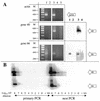Varicella-zoster virus gene 66 transcription and translation in latently infected human Ganglia
- PMID: 12767985
- PMCID: PMC156202
- DOI: 10.1128/jvi.77.12.6660-6665.2003
Varicella-zoster virus gene 66 transcription and translation in latently infected human Ganglia
Abstract
Latent infection with varicella-zoster virus (VZV) is characterized by restricted virus gene expression and the absence of virus production. Of the approximately 70 predicted VZV genes, only five (genes 4, 21, 29, 62, and 63) have been shown by multiple techniques to be transcribed during latency. IE62, the protein product of VZV gene 62, is the major immediate-early (IE) virus-encoded transactivator of viral gene transcription and plays a pivotal role in transactivating viral genes during lytic infection. The protein kinase (66-pk) encoded by VZV gene 66 phosphorylates IE62, resulting in cytoplasmic accumulation of IE62 that mitigates nuclear IE62-induced gene activation. Analysis of latently infected human trigeminal ganglia for 66-pk expression by reverse transcriptase-dependent nested PCR, including DNA sequence analysis, in situ hybridization, and immunohistochemistry, revealed VZV open reading frame 66 to be a previously unrecognized latently expressed virus gene and suggests that prevention of IE62 import to the nucleus by VZV 66-pk phosphorylation is one possible mechanism by which VZV latency is maintained.
Figures



References
-
- Cohen, J. I., and S. E. Straus. 2001. Varicella-zoster virus and its replication, p. 2707-2730. In D. M. Knipe and P. M. Howley (ed.), Fields virology, 4th ed. Lippincott Williams and Wilkins, New York, N.Y.
-
- Cohrs, R., R. Mahalingam, A. N. Dueland, W. Wolf, M. Wellish, and D. H. Gilden. 1992. Restricted transcription of varicella-zoster virus in latently infected human trigeminal and thoracic ganglia. J. Infect. Dis. 166:S24-S29. - PubMed
Publication types
MeSH terms
Substances
Grants and funding
LinkOut - more resources
Full Text Sources
Other Literature Sources

